Sri Hanumanji
1
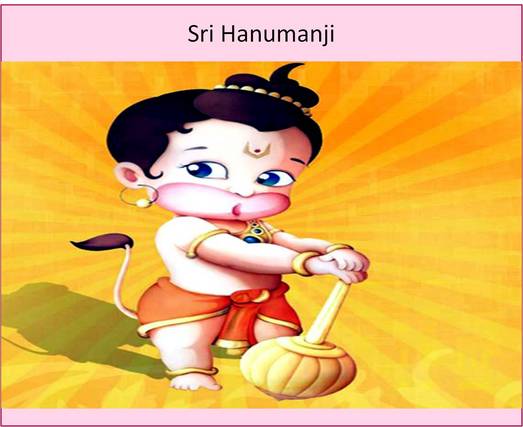
Lord Hanuman is the embodiment of Divine Faith. The literal meaning of Hanuman is broken chin (inner meaning is one who has let go of pride/ego) He is invoked and worshipped by the Hanuman Chalisa—the glorification of Lord Hanuman in forty verses composed by Saint Tulsi Das. For centuries, the Hindus in India have recited this Hanuman chalisa for facing the baffling problems of life, for finding peace and solace in adverse conditions, for spiritual enrichment, for success in every walk of life and for attaining the goal of life—Bhakti and Mukti (devotion to God and Liberation). My father has been an ardent devotee and personally for me he is my friend and support 🙂 I always thought that this symbolism had a deeper meaning for our life and hence wanted to share this with all of you.[ad name=”HTML”]
Why a Monkey God?
2
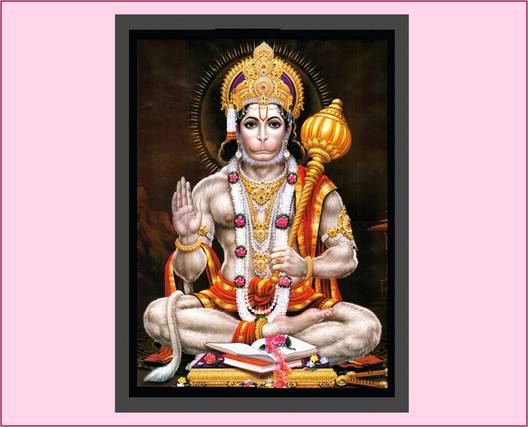
The mind is like a monkey, ever restless, full of distractions. However, when shraddha (faith) in an aspirant is touched by Rama (Ishwar bhakti), it begins to grow like a mystic tree. Faith leads to veerya (spiritual strength), which in turn promotes smriti (spiritual memory). Instead of vishaya chintan, (moving outward into the world of multiplicity and distraction), the mind turns to Ishwar chintan moving towards God in a progressive manner. This results in experiencing samadhi (super-consciousness) in a gradual ascent. The intellect in an aspirant passes through shraddha, veerya, smriti and samadhi and finally turns into prajna (intuitive wisdom that reveals, “I am Brahman.”)
[ad name=”HTML”]
Hanuman Chalisa
3
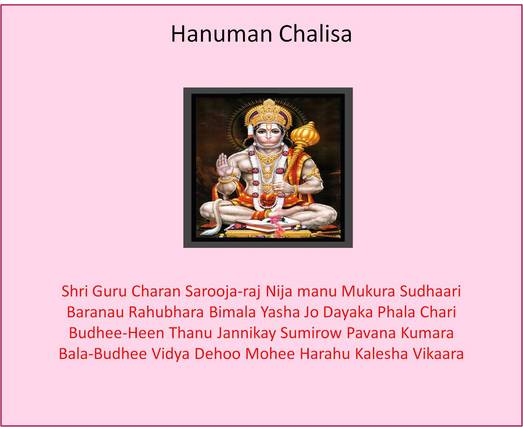
Attaining Liberation or Moksha through Rama-bhakti (Divine Love) is the goal of life. To reach this goal, an aspirant must approach a Guru. “Applying the dust of His lotus feet” implies that he should practice Integral Yoga—a rhythmic blend of Serve, Love, Meditate, and Realize under Guru’s guidance. This will result in purity of the heart (chitta shuddhi). Humility is the starting point. One must understand that whatever he knows is little. All intellectual knowledge is little. The knowledge that leads one to attain God-realization is possible only if one has installed Hanuman (Divine Faith) in his heart, and has come under His gracious guidance.
Hanuman Chalisa
4
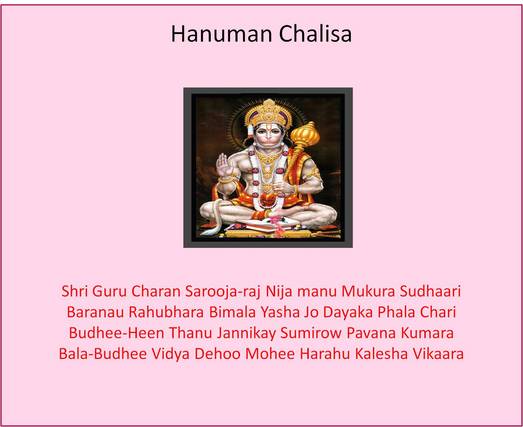
Bala: Spiritual strength to face the obstacles.
Budhi (Buddhi): Insight into the removal of obstacles.
Vidyaa: Two types of Knowledge (indirect or theoretical, and direct or intuitional knowledge). Kales (Kleshas) or afflictions: Avidya (ignorance), asmita (egoism), raga(attachment), dwesha (hatred) and abhinivesha (clinging to life, or fear of death). These kleshas exist in the form of subtle impressions in the unconscious. They create distractions (vikshepa) in the mind and become the cause of vikaras or impurities (mala). There are are six major vikaras: Kama (lust), krodha (anger), lobha (greed), moha (delusion), mada (pride), and matsarya (jealousy).
Hanuman Chalisa
5
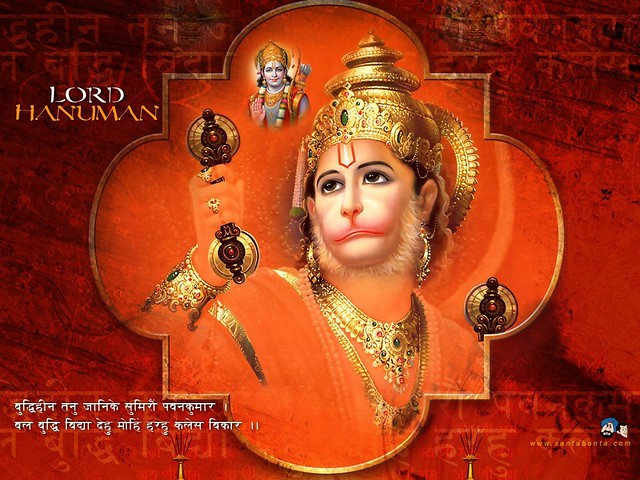
“Jai Hanuman gyan gun sagar
Jai Kapis tihun lok ujagar” Lord Hanuman helps one to develop jnana guna—the cultivation of divine virtues that serve as indications of one’s progress on the spiritual path. These include humility, surrender to God, absence of violence, truthfulness and other related virtues. With a prayerful mind one must invoke the presence of Hanuman within the heart in the form of faith. Such an entry is the fountain source of all that is true, good and sublime in the three worlds—in the physical, mental and causal planes of one’s existence. Thus, Hanuman is the illumine of the three worlds.
Hanuman Chalisa
6
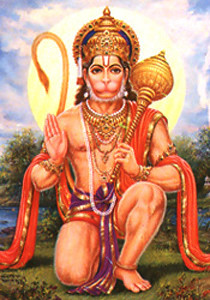
“Ram doot atulit bal dhama
Anjaani-putra Pavan sut nama” In the Ramayana, Hanuman is the son of the monkey hero Kesari (Lion-like resolve), and mother Anjani (beautifying collyrium—the Divine feeling applied to the vision of the soul). God in the form of Cosmic Prana (an aspect of the Cosmic Mind) is the Divine Father. In fact, Hanuman is a ray of Lord Shiva (Brahman). The emergence of faith in the heart of an aspirant is the result of all these mystical elements.
Hanuman Chalisa
7
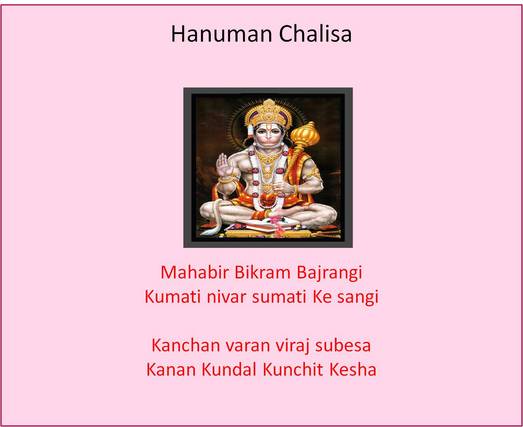
Valor or Strength in an aspirant expresses itself in three planes—physical-vital (bhuh), mental (bhuvah) and causal (swah). Physical-vital valor is needed for handling the practical realities and responsibilities of daily life. Mental valor enables one to practice reflection and meditation, enriching oneself with positive impressions. Spiritual valor enables one to develop viveka, the discerning vision that separates the Self from the not-self, and thus lifts the veil of avidya (ignorance). Keeping this in view, Hanuman’s movement is like a thunderbolt for removing obstacles in life, for correcting wrong knowledge (misunderstanding) and its disastrous effects, and for promoting the knowledge that enables the soul to realize, “I am That Rama—the Absolute Self.”
Hanuman Chalisa
8
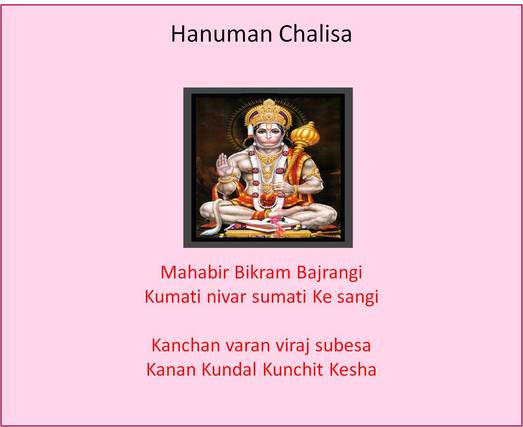
Gold (the shining splendor of Hanuman) is the mystic symbol of Hiranyagarbha(Cosmic or intuitive mind). Ears adorned with earrings implies He finds delight in listening to the glory of Rama. It is believed that wherever and whenever the Ramayana is read, Hanuman (in an invisible form) presents himself with wistful ears adorned with mystic earrings, craving more and more to listen to the delightful narratives of Lord Rama. Curly hair symbolizes the constant thrill of devotion that sweeps over Him.
Hanuman Chalisa
9
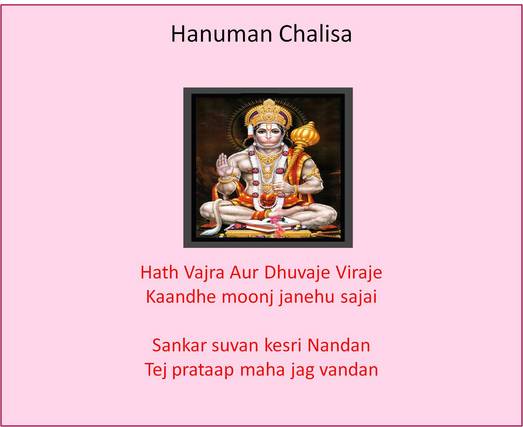
He destroys the obstacles like a thunderbolt of lightning splitting up mighty trees, and His banner blesses the devotee with spiritual victory. The sacred thread with Munja grass is symbolic of Divine resolutions (maha vratas or great vows of non-violence, truthfulness, purity, etc. blended with vairagya or dispassion). He is a ray (an incarnation) of Lord Shiva blended with the vital aspect of being the son of the monkey leader, Kesari. Thus, He is the very embodiment of a mystic blend of grace (Lord Shiva) and self-effort (symbolized by Kesari).
Hanuman Chalisa
10
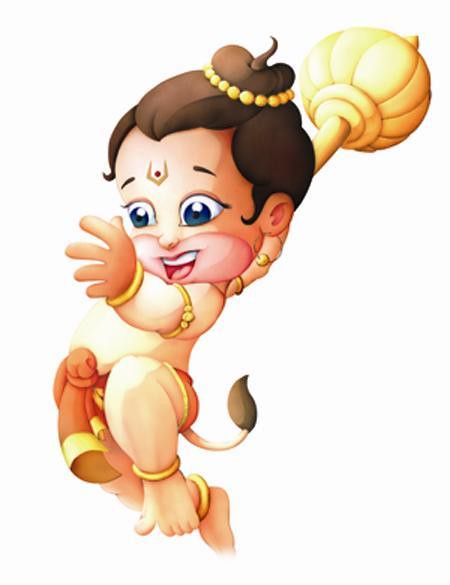
“Vidyavaan guni ati chatur
Ram kaj karibe ko aatur” Lord Hanuman is the ideal to be emulated by an aspirant. These four qualities abide in Lord Hanuman in full measure: Vidyavan—Means Absolute knowledge: “Ayam Atma Brahman”—“This innermost Self is the Absolute Brahman or Rama). Guni—Indicates virtuous qualities such as humility, compassion, generosity, tenacity, etc. Ati-chatur—One who is supremely skillful. Skill in life expresses itself in two stages. Developing skill for intensifying one’s virtuous karmas (pravritti); and developing profound skill for turning away from the world of pravritti (cycle of birth and death) and pursuing the path of nivritti (renunciation) that leads to Bhakti and Mukti. When these qualities are developed, the spirit of Hanuman blossoms in an aspirant. He is ever ready to live and act according to the Divine Will of Rama.
Hanuman Chalisa
11

“Prabu charitra sunibe-ko rasiya
Ram Lakhan Sita man Basiya ” It is believed that whenever and wherever the Ramayana is recited, or a divine satsanga is conducted, Lord Hanuman presents Himself in an invisible manner. He delights in listening to the glories of Rama and does not miss even the slightest opportunity to do so. Therefore, He abides in the heart of Rama, Lakshmana and Sita, forever ! This is the allegorical presentation of Divine Perfection: Abiding in the heart of Sita (Vidya-devi) is to delight the world, like the Spring season delighting a forest. Abiding in the heart of Lakshmana is to be in tune with the Will of God. Abiding in the heart of Rama is to be One with Rama.
Hanuman Chalisa
12
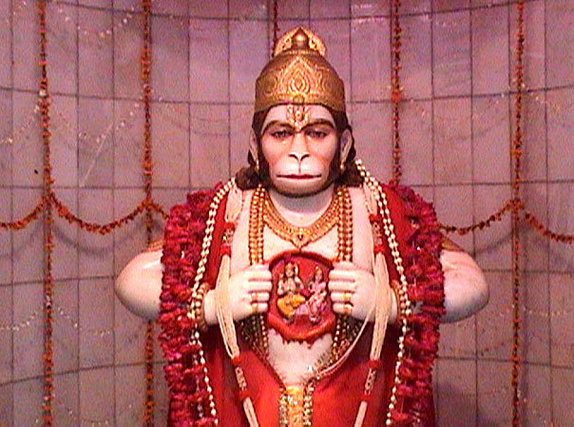
Vidyavaan guni ati chatur
Ram kaj karibe ko aatur Lord Hanuman is the ideal to be emulated by an aspirant. These four qualities abide in Lord Hanuman in full measure: Vidyavan—Means Absolute knowledge: “Ayam Atma Brahman”—“This innermost Self is the Absolute Brahman or Rama). Guni—Indicates virtuous qualities such as humility, compassion, generosity, tenacity, etc. Ati-chatur—One who is supremely skillful. Skill in life expresses itself in two stages. Developing skill for intensifying one’s virtuous karmas (pravritti); and developing profound skill for turning away from the world of pravritti (cycle of birth and death) and pursuing the path of nivritti (renunciation) that leads to Bhakti and Mukti. When these qualities are developed, the spirit of Hanuman blossoms in an aspirant. He is ever ready to live and act according to the Divine Will of Rama.
Hanuman Chalisa
13
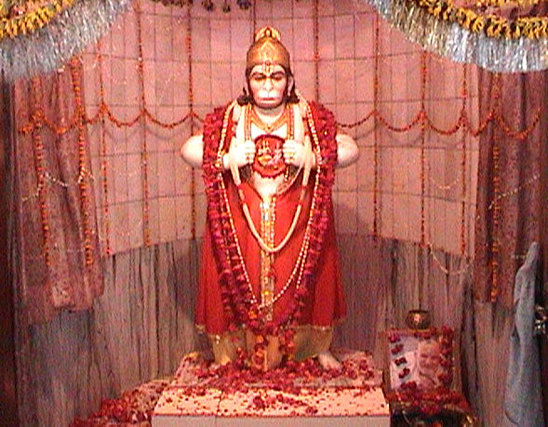
Prabu charitra sunibe-ko rasiya
Ram Lakhan Sita man Basiya It is believed that whenever and wherever the Ramayana is recited, or a divine satsanga is conducted, Lord Hanuman presents Himself in an invisible manner. He delights in listening to the glories of Rama and does not miss even the slightest opportunity to do so. Therefore, He abides in the heart of Rama, Lakshmana and Sita, forever ! This is the allegorical presentation of Divine Perfection: Abiding in the heart of Sita (Vidya-devi) is to delight the world, like the Spring season delighting a forest. Abiding in the heart of Lakshmana is to be in tune with the Will of God. Abiding in the heart of Rama is to be One with Rama.
Hanuman Chalisa
14
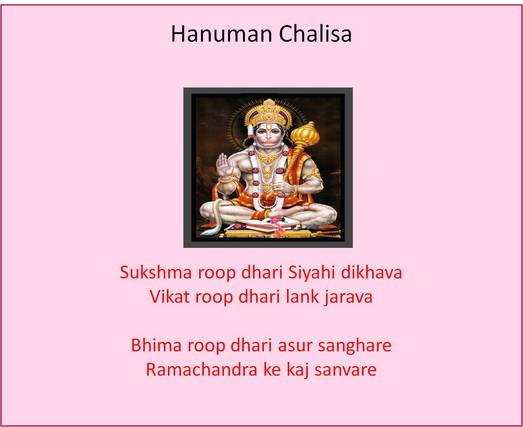
Sita Devi is the embodiment of Pure Buddhi or Intellect. The Ramayana highlights the story of the soul from the state of bondage to the glorious state of Liberation. The soul (Rama), having broken Shiva’s bow (the illusion ofpravritti), weds Sita (buddhi). Sita is held captive in Lanka (unconscious mind) by the Demon of Ignorance (Ravana) and its demoniac forces. Rama sends Hanuman to discover Sita and prepare for fighting against Ravana and his demonic forces. Hanuman approaches Sita in a subtle form as faith rises to the state of constant Ishwar smaran (remembrance of God). The subtle form relates to glimpses of samadhi (superconsciousness). Sukshma roop (the subtle form) is the power of ichha shakti (willpower), while vikat-roop (unimaginable form) relates to the overhauling of the unconscious impressions. The ashubha samskaras (the impure impressions) are destroyed, paving the way for Rama’s movement to Victory.
Hanuman Chalisa
15
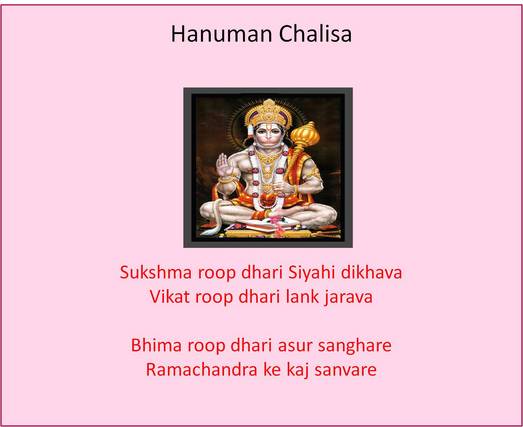
Bheem-roop (terrible form) is the manifestation of kriya shakti, or the mystic energy that handles the vikaras (impurities) of the mind—lust, anger, greed, infatuation, pride and jealousy. An aspirant on the path of sadhana experiences the manifestation of three forms of energy—jnana, ichha, and kriya—represented by kundalini shaktipassing through Manipura, Anahata and Ajna Chakras. Hanuman (the spirit of shraddha) assumes these forms to enable the soul to regain its essential nature (Rama’s mission).
Hanuman Chalisa
16

Laye Sanjivan Lakhan Jiyaye
Shri Raghuvir Harashi ur laye Lakshmana is the embodiment of willpower. The affliction of ego-sense(asmita-klesha) is represented by the terrible demon Megh-naad (one who roars like a thundering cloud). It is the demoniac ego-sense that resounds through one’s rajasic and tamasic samskaras (impressions) and vasanas (subtle desires), shutting out the melody of the mystic Presence of God. (Samskaras or deep rooted impressions are like seeds, while subtle inclinations or vasanas are like sprouts.) If the mind is dominated by ego, it is as if dominated by ego’s terrible sounds. Megh-naad is also known as Indra-jeet (he who conquered Indra). Indra is symbolic of swarga (relative heaven) acquired by dharma (virtuous karmas). The evil role of Megh-naad (ego-sense) threatens even the enjoyment of that relative heaven, since the soul that has attained swarga without rooting out ego must eventually incarnate again and again in the cycle of birth and death.
Hanuman Chalisa
17
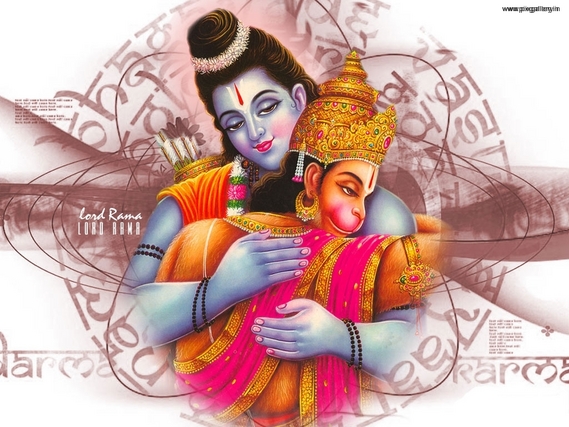
Raghupati Kinhi bahut badai
Tum mam priye Bharat-hi-sam bhai Rama’s love for Bharata is immense. Bharata is the embodiment of Para Bhakti(supreme devotion). In Bharata, bhavana (feeling of the heart) rises to the highest level. Whoever ascends the ladder of bhakti comes closer and closer to God. It is Hanuman who leads one to the goal of Supreme Devotion. Therefore, devotion to Hanuman is the surest way of securing the Love of Rama (God).
Hanuman Chalisa
18
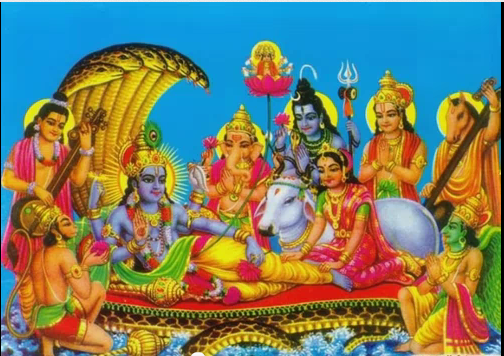
Sahas badan tumharo yash gaave
Asa-kahi Shripati kanth lagaave The thousand-hooded Shesha Naga, the mystical serpent who holds the universe on his thousand hoods, and is symbolic of the Cosmic Mind, sings of Your Glory through His thousand tongues.” Thus saying, Lord Rama enfolded You in His Arms. Shesha Naga is symbolic of the Cosmic Mind. The entire universe is sustained by the thought-waves (hoods) of the Cosmic Mind (Shesha Serpent). There isn’t even a particle of the universe that does not express the glory of Hanuman (Divine faith). There are two stages in spiritual ascent: 1. The world sings the glory of the devotee. Basant-vat loka hite charantah—A devotee moves in the world like the Spring season in a rich forest, decking the forest with beauteous blossoms and delicious fruits. 2. The devotee merges in God as God enfolds him in His infinite love.
Hanuman Chalisa
19
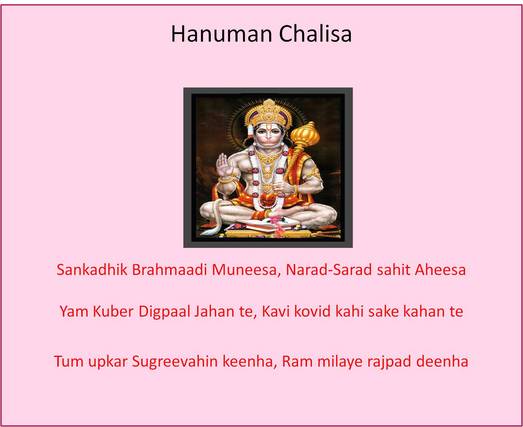
While the world is sustained by the glory of God in general, the enlightened beings are profoundly immersed in singing the glory of God by praising Lord Hanuman. While the sun creates a general illumination everywhere, it creates a special splendor in sheets that are made of gold and silver. It is the glory of God that sustains the cosmic functions performed by Yama (god of death), Kubera (god of wealth), as well as all the Divine poets (sages-saints) and inspired beings of the past, present and future. All their inspired actions and eloquent expressions are unable to encompass the boundless glory of Hanuman In the mystic story of the Ramayana, it is with the help of Hanuman that Lord Rama is able to destroy Bali (the lower self), and enthrone Sugriva (the higher self). Bali represents the lower self, while Sugriva is the higher self. pass the boundless glory of Hanuman.
Hanuman Chalisa
20
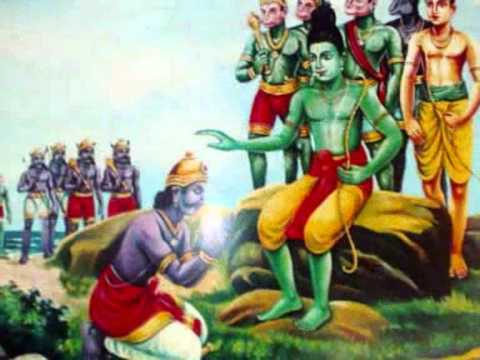
Tumharo mantra Vibheeshan maana
Lankeshwar Bhaye Sub jag jana
Under Hanuman’s guidance Vibhishana (the quality of sattwa) was able to abandon Ravana (the dominion of ignorance). This facilitated Rama’s project of destroying Ravana. This gives you a glimpse into the state of Enlightenment. As faith (Hanuman) progresses in an aspirant, sattwa in him (Vibhishana) is led to rise beyond the pull of rajas (Ravana) and tamas (Kumbhakarna) That sattwa (Vibhishana) becomes increasingly potent for aiding Rama (the soul) in the eventual destruction of Ravana (ignorance and the forces of darkness).
Hanuman Chalisa
21
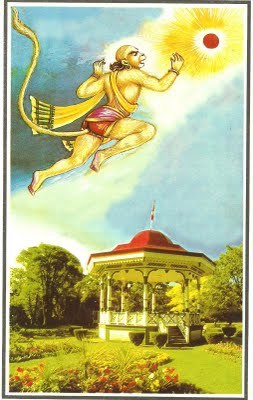
Yug sahastra jojan par Bhanu
Leelyo tahi madhur phal janu In this context, the sun is the symbol of the highest attainment in this relative world. Swarga or heaven is the goal of sakamya karma or pravritti marga (the path of enjoying fruits of karma). Hanuman enables the aspirant to develop aspiration for nivritti or Liberation. It is interesting to note the mystical implication of an episode in Hanuman’s childhood. Even as a child, He bounced towards the sun, believing it to be a shining fruit in the sky and then placed the sun in his mouth. To save the world from utter darkness, Indra, the Lord of heavenly gods, struck him with his thunderbolt (the force of pravritti). This broke the chin of Hanuman (removal of pride). Thus, the very name Hanuman (broken chin) beckons the mind of the aspirant to humility, an unmistakable devotional quality that leads the devotee to the highest goal.
Hanuman Chalisa
22
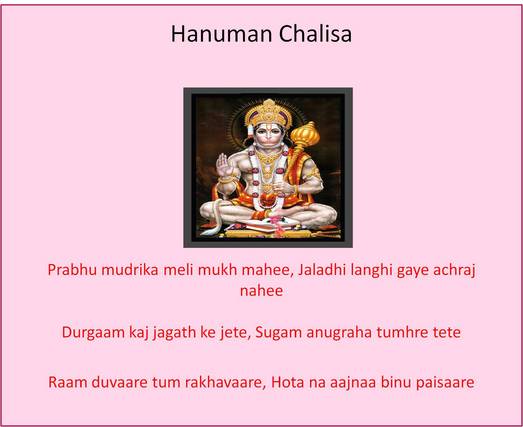
Keeping the ring of Lord Rama in the mouth implies being profoundly involved in japa (repetition of the Divine Name). Once the Name (Rama) has appeared on the lips, it begins to work wonders. It becomes like a lamp placed at the threshold of a house that illumines the inner world (the mind and heart) as well as the external world (the world of practical reality). Therefore, a devotee carrying the ring (Divine Name) crosses over the ocean of the world-process and finds Sita (intuitive intellect), thus paving the way to Rama-Rajya (Bhakti and Mukti). By securing the grace of Hanuman (the growth and blossoming of faith), an aspirant is able to connect himself with God within his heart. Grace blended with self-effort is the formula for amazing success in all perplexing and confounding situations of life. Without securing the Grace of Hanuman (faith and its progressive growth), no one can become a true devotee of God. It is Hanuman (faith) who guards the Royal Gate of Rama (Liberation). He paves the way to Enlightenment.
Hanuman Chalisa
23
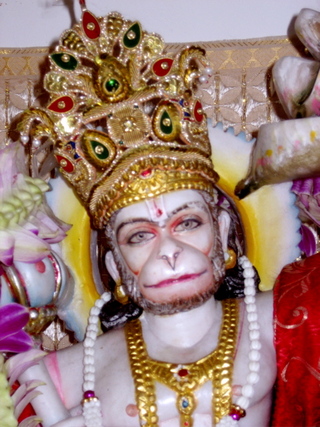
Without securing the Grace of Hanuman (faith and its progressive growth), no one can become a true devotee of God. It is Hanuman (faith) who guards the Royal Gate of Rama (Liberation). He paves the way to Enlightenment.
Hanuman Chalisa
24
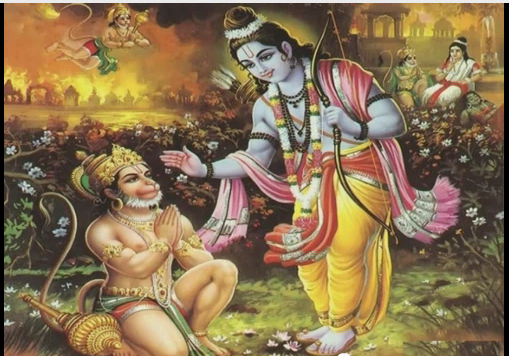
Ram dwaare tum rakhvare
Hoat na agya binu paisare
Sub sukh lahae tumhari sar na
Tum rakshak kahu ko dar naa Aapan tej samharo aapai
Teenhon lok hank te kanpai Without securing the Grace of Hanuman (faith and its progressive growth), no one can become a true devotee of God. It is Hanuman (faith) who guards the Royal Gate of Rama (Liberation). He paves the way to Enlightenment. By taking refuge in Hanuman, the devotee is given guaranteed protection against all dark and demoniac forces of the world. In addition, he is led to attain Rama (God-realization), Who destroys all fear. Just as the dazzling sun fills the world with effulgence, in the same way, Hanuman’s presence shines through every name and form. All the planes of existence—bhuh (physical), bhuvah (mental) and swah (intellect and deep unconscious)—are under the control of Lord Hanuman. He strikes terror in the heart of the demonic forces.
Hanuman Chalisa
25
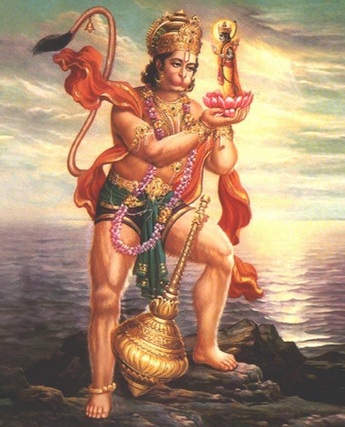
Bhoot pisaach Nikat nahin aavai
Mahavir jab naam sunavae
Nase rog harae sab peera
Japat nirantar Hanumant beera From an advanced point of view, the worries and anxieties pertaining to past and future keep one’s mind extremely afflicted. They are the bhutas andpishachas that are dispelled by the japa of Hanuman’s Name. The root disease is ignorance (avidya), which keeps the soul confined to the cycle of birth and death. Ignorance, in turn, gives rise to mental diseases (adhis) in the form of egoism, greed, delusion, grief, anxiety, stress, negative thoughts and feelings. Mental diseases impact upon the vital forces that maintain physical health. This brings about imbalance in the three humors—vata (rheumatic), pitta (bilious), and kapha (phlegmatic). As a result, physical diseases manifest in the body. As you invoke Lord Hanuman in your heart, you are paving the way to the removal of adhis, vyadhis (mental and physical diseases) along with the moola adhi (ignorance).
Hanuman Chalisa
26
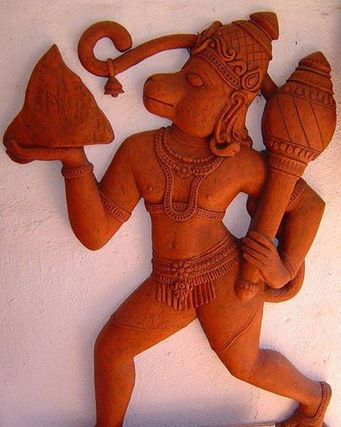
Sankat se Hanuman chudavae
Man Karam Vachan dyan jo lavai
Sab par Ram tapasvee raja
Tin ke kaj sakal Tum saja Japa is intensified by meditation or devotional feeling (bhavana). One must begin repeating the mantra vocally– holding the Name on his tongue. Gradually the spirit of devotion must permeate all his actions, allowing his mind to be immersed in Rama at all times. Lord Rama (Brahman) is the Lord of all those who practice tapasya or austerity. The highest form of tapasya is to focus the mind on Brahman (Rama—the Absolute Self). Hanuman (shraddha or faith) paves the way to the attainment of Rama. Therefore, devotion to Hanuman accomplishes all that is needed by an aspirant for attaining Rama.
Hanuman Chalisa
27
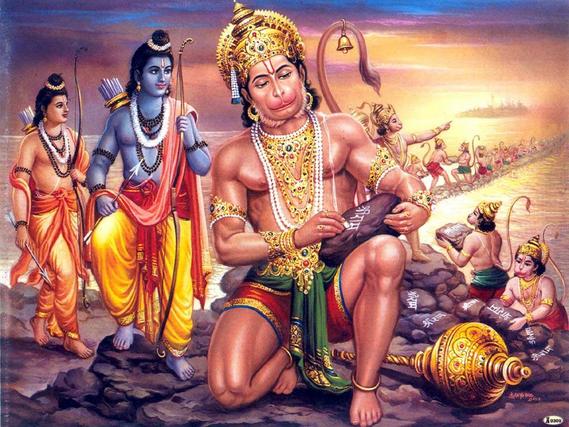
Aur manorath jo koi lavai
Sohi amit jeevan phal pavai
God-ward movement of the mind is the bestower of bhoga (enjoyments of the world) as well as Moksha (Liberation). Movement to Moksha requires chitta shuddhi (purity of the heart). Even while an aspirant is struggling in the world of transient goals, Hanuman’s grace bestows upon him all that he desires: removal of obstacles, attainment of objects, improvement in human relations, relief from maladies of body and mind, prosperity and success of all kinds. His blessings have no limits.
Hanuman Chalisa
28
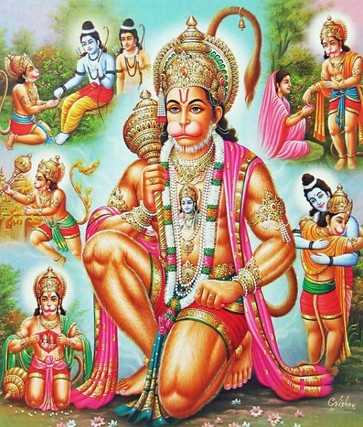
Charon Yug partap tumhara
Hai persidh jagat ujiyara
The importance of faith (Hanuman) in spiritual movement is timeless. From a practical point of view, the yugas are experienced in the daily life of every individual. When sattwa predominates, you are in Satya Yuga. You are able to think clearly and feel qualitatively. When sattwa is overpowered by rajas, you are in Treta Yuga. The intellect—Sita Devi—has been kidnapped by the distracted mind (the ten-headed Ravana). When sattwa is further thwarted by rajas and tamas, you are in Dwapar Yuga (Refer to battle of the Pandavas and Kauravas—forces of light against the dark forces). When rajas-tamas reduces sattwa to a minimum, when you are overpowered by stress, dullness, and delusion, you experience Kali Yuga. The role of faith (Hanuman) is the center and support in all these yugas.
Hanuman Chalisa
29
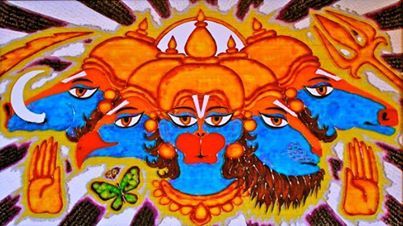
Sadhu Sant ke tum Rakhware
Asur nikandan Ram dulhare God incarnates for establishing dharma (righteous order), destroying the forces of darkness, assisting spiritual seekers, protecting saints and sages and doing immense good to the world. Hanuman (the spirit of faith) assists Rama (the Avatara movement) in all His Divine activities
Hanuman Chalisa
30
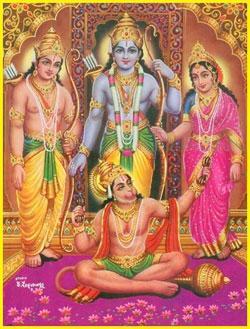
A devotee of Hanuman draws the grace of Rama and Sita (the Father and Mother of the Universe). As a result Hanuman becomes the bestower of all the eight siddhis and nine nidhis. The ashta siddhis (the eight major psychic powers) include: anima (becoming small), laghima (becoming light in weight), mahima (becoming large), praapti(attaining whatever one desires), praakaamya (unobstructed fulfillment),vashitva (control of five elements and physical objects), ishitritva (ability to create and destroy objects), yatra-kaama-asaayitva (infallible will—ability to turn poison into nectar). The nava nidhis (nine treasures of Kubera, the God of Wealth) appear in the form of celestial women who attend on Kubera. They are Padma (lotus), Maha-padma (great lotus), Shankha (conch), Makara (crocodile), Kachhapa (tortoise), Mukuda (divine lotus), Kunda (special lotus), Neela (blue jewel) and Barchh (aromatic plant). All these are symbolic of wealth in different forms.
Hanuman Chalisa
31
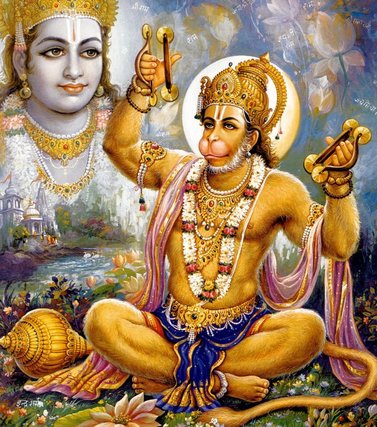
Ram rasayan tumhare pasa
Sada raho Raghupati ke dasa In the Ramayana, there is an interesting episode. Lord Rama asks Hanuman, “How are you related to me?” To this, Hanuman replies: “Deha-budhyaa tu daasoham, Jiva buddhya twadanshakah, Atma budhyaa tavaivaaham, esha me trividhaa matih.”—“From the point of view of the body, I am a slave and You are the Master. From the point of view of the individual soul, I am a fraction (just a ray), while You are the Whole (the Sun). But from the point of view of the innermost Self, I am You. Thus, in my view we have a three-fold relationship.”
Hanuman Chalisa
32
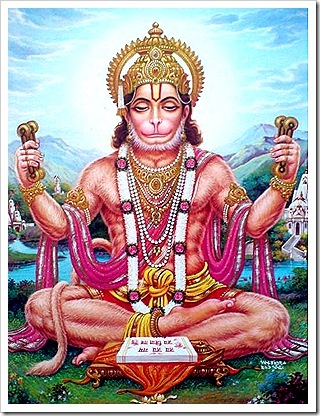
The japa of Rama enables an aspirant to become a dynamic Karma Yogi (a servant of Rama), and a profound devotee (a ray of the Divine Sun—Rama). Leading him through the royal path of meditation and intuitive knowledge, thejapa of Rama enables him to realize, “I am That Absolute Self!” The spiritual journey commences with “Daasoham”—“I am a slave of Rama” and culminates in the realization, “So’ham”—“I am That Rama!” The miseries of the world-process (the cycles of birth and death) terminate in God-realization. Anth-kaal Raghuvir pur jayee Jahan janam Hari-Bakht Kahayee During the time of death, the soul of the devotee is led to the City of Rama (lofty state of consciousness), where he becomes steeped in Rama-bhakti(Para-Bhakti). Moksha and Para-Bhakti are one and the same.
Hanuman Chalisa
33
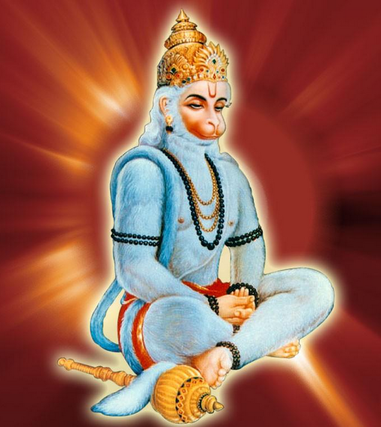
Aur Devta Chit na dharehi Hanumanth se hi sarve sukh karehi An aspirant must worship his Ishta Devata with the help of his Ishta mantra(Rama) with the insight that all Gods and Goddesses are different aspects of Rama (THE God). As long as the mind is restricted by desires (sakamya), it cannot grasp the Non-duality of the Self. An aspirant who lacks purity of heart turns to God for transient attainments. In so doing, he is worshipping “other gods.” Since Hanuman is the gateway to Rama, a devotee should develop unwavering devotion to Him. This is the secret of attaining the boundless ocean of Divine Bliss. In other words faith is the key to attaining inner awakening whatever path you take is irrelevant.
Hanuman Chalisa
34
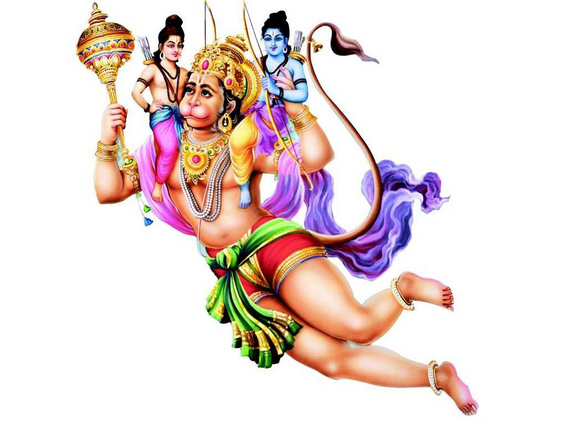
Sankat kate-mite sab peera
Jo sumirai Hanumat Balbeera By letting the mind dwell on Lord Hanuman—by repeating the Mantra, “Om Sri Hanumate Namah!” (or any Ishta Mantra), blended with divine feeling and the act of surrender, all adversities are overcome, all miseries come to an end. This is the goal of Hanuman-smaran, constant remembrance of Lord Hanuman, Who is the boundless source of spiritual strength.
Hanuman Chalisa
35
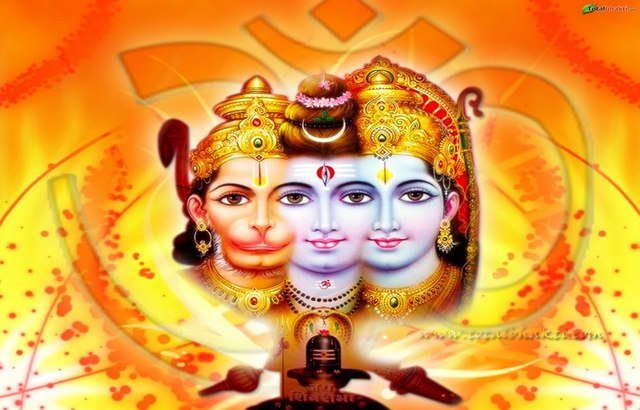
Jai Jai Jai Hanuman Gosahin
Kripa Karahu Gurudev ki nyahin
Jo sat bar path kare kohi
Chutehi bandhi maha sukh hohi Divine Grace appears in four forms: Ishwar Kripa (Grace of God), Guru Kripa(Grace of Guru), Shastra Kripa (Grace of scriptures) and Atma-Kripa (Grace of one’s own self). By adoring Hanuman (Divine faith) an aspirant becomes the recipient of all the four forms of Grace. Since the Hanuman Chaleesa has been recited by countless devotees from ancient times, it has gained immense mantra-related potency. Recitation of a mantra can be done in three ways: vaikhari (verbal), upanshu (semi-verbal or whispering), and mahasik (mental). As devotional feeling deepens, the japa becomes increasingly mental. Reciting “a hundred times” simply implies sustained practice of japa until the goal is reached.
Hanuman Chalisa
36
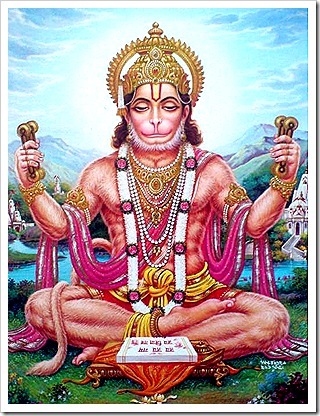
Not a single recitation of the Hanuman Chalisa goes in vain. A devotee continues to be enriched spiritually until he becomes free of the bondage of the world-process and attains the supreme bliss of Liberation. This is the firm declaration made by Saint Tulsidas in the name of Lord Shiva.
Hanuman Chalisa
37

Tulsidas sada hari chera
Keejai Nath Hridaye mein dera Pavan-tanay sankat haran mangal moorati roop,
Raam lakhan seetaa sahit hriday basahu sur bhoop. During spiritual movement, a transformation occurs in the heart of the devotee. In the sadhana state, the state of spiritual discipline, Lord Hanuman (shraddha or faith) holds Rama (the goal of life—God-realization) and Lakshmana (purity of heart) on His shoulders. Turning the mind to Hanuman invokes the presence of Rama accompanied by Lakshmana (purity of mind) and Sita (intuitive Intellect). In the siddhi state (the state of perfection), Rama and Sita are seated on the throne. Lakshmana and his brothers Bharata and Shatrughna (Cosmic Mind in all its glory) attend on Rama, while Hanuman (the spirit of Divine Love) continues to adore the Lotus Feet of Rama forever! This is an allegorical setting of Para Bhakti (Supreme Devotion) or Moksha (Liberation). This is the cherished goal of Saint Tulsidas, the composer of Hanuman Chalisa.
Om Sri Hanumate Namah!!!!
38
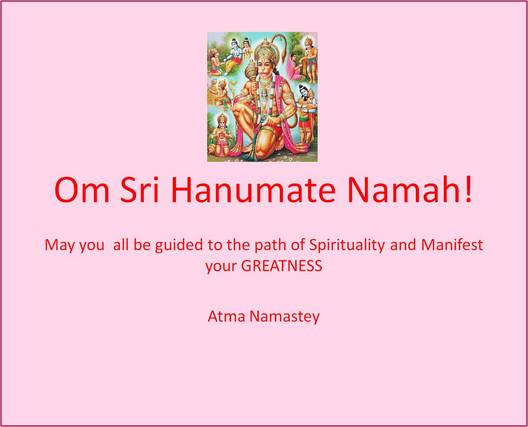
Rama’s story is a mystical portrayal of how the soul, having entered the forest of the world-process, struggles to attain Liberation. By practicing various spiritual disciplines, by integrating the energy operating through the mind and senses and acquiring the army of vital forces (the monkeys and bears), and by befriending sattwa or purity (Vibhishana), the soul destroys Ignorance (Ravana). Thus the soul is united with Sita, the intuitive intellect, which bestows upon the soul the knowledge of its essential nature and allows it to become free of the bondage of the world and enjoy infinite bliss. Human life is a battlefield where divine and demoniac forces continue to fight against each other. Self-realization is the victory that must be acquired during one’s lifetime.[ad name=”HTML”]